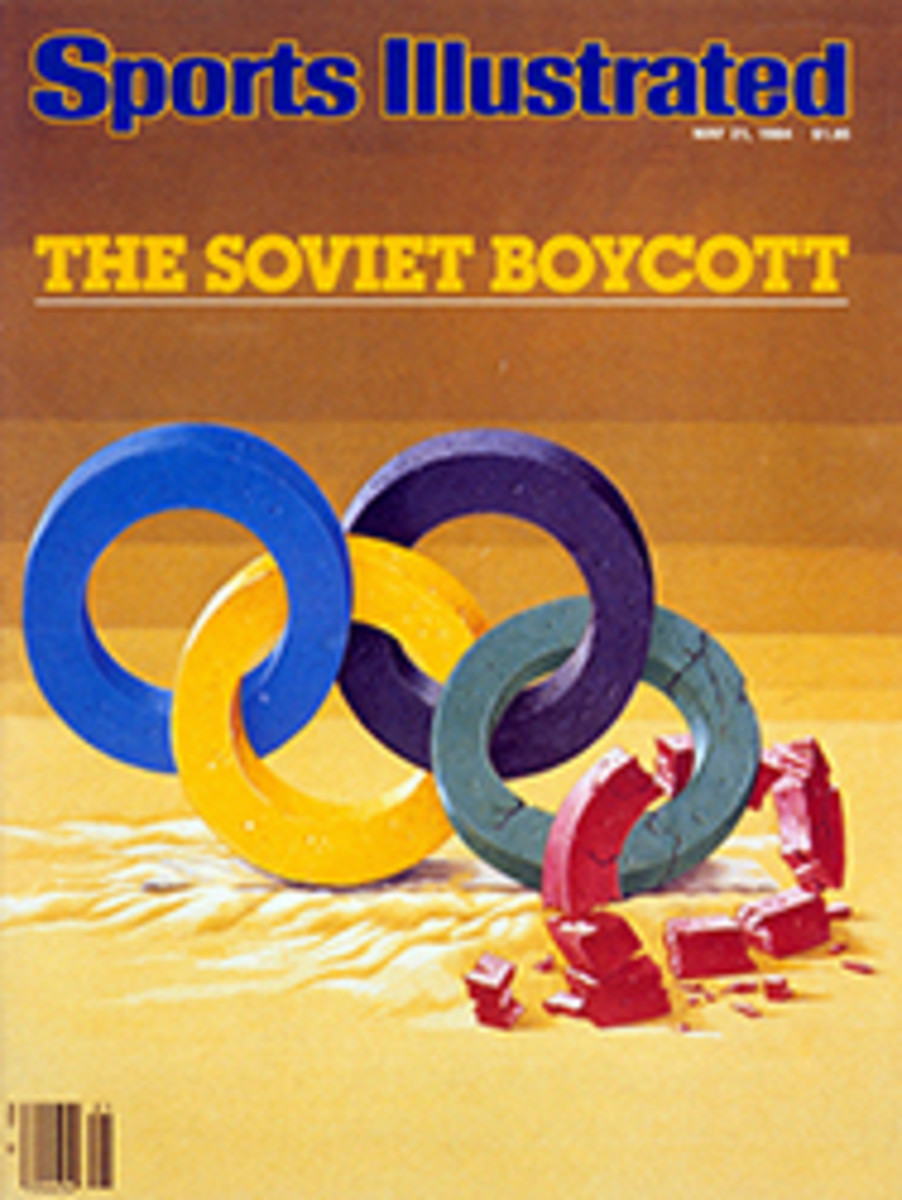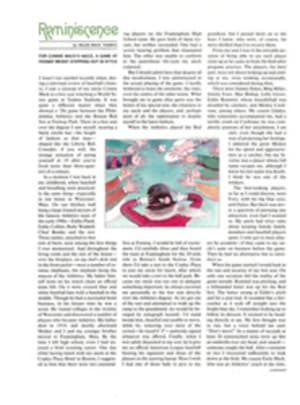
A CATCHY INTRO TO A CHEER BECAME MUSIC TO THE EARS OF MYRIAD FANS
Albert Ahronheim is a composer laboring in relative obscurity in Brooklyn. Joe Carl is the band director at Central Kitsap High School in Silverdale, Wash., a community of about 1,500 on the Olympic Peninsula.
Neither name is familiar, but Carl and Ahronheim might well be considered the Rodgers and Hammerstein of musical cheers, for they've left a unique—and quite recognizable—mark on amateur spectator sports. As members of the University of Michigan marching band in the mid-1970s, Carl, a sousaphonist, and Ahronheim, then an assistant to the conductor, and formerly a drum major, collaborated on a short, bouncy musical introduction to the school's traditional nonmusical shout, "Let's Go Blue!"
The tune is Carl and Ahronheim's masterwork—and only work—and can be heard at sporting events across the country. If you've seen a high school or college football game in the past few years, there's a very good chance you've heard the tune.
It's crowd-pleasing, melodic, rhythmic, catchy—and copyrighted. Nearly every time the 32-bar, 40-second tune is broadcast, Carl and Ahronheim cash in, to the tune of around $1,000 apiece in a typical year. It's not as lucrative as owning the rights to Yesterday or Misty, but Carl makes far more than he ever expected to the night he first played the tune's simple, distinctive bass line on his sousaphone inside Ann Arbor's Yost Ice Arena 10 years ago.
Casting about for a rousing handclapper to play during breaks in a hockey game, Carl, then a 19-year-old sophomore, settled on an ascending five-note phrase, repeated three times and ending with the original note played three times. (Specifically, the phrase starts with an interval of a major third, followed by three half-steps. It can be played C-E-F-F#-G.) The crowd began to respond enthusiastically, clapping along and shouting "Let's Go Blue!" in cadence with the last three notes.
George Cavender, the band director, knew a good thing when he heard it. Cavender asked Ahronheim to write a version based on Carl's original oompahs for the entire band. The resulting score—for piccolo, clarinet, alto and tenor saxophones, trumpet, alto horn, trombone, baritone horn, percussion and, of course, sousaphone—included Ahronheim's own contrapuntal melodies and chord progressions. It had its debut in September 1975, before more than 100,000 fans at the Stanford game in Michigan Stadium.
This full, jazzy version caught on quickly, and the tune was soon adopted by high school bands in Michigan and borrowed by other colleges, which simply substituted their own three-syllable cheer at the end. Over the next couple of years, renditions of Ahronheim's distinctive brassy version, which had been filed with the U.S. Copyright Office, started to pop up everywhere.
In West Lafayette, Ind., it was the "Go Purdue" cheer; in Norman, Okla., fans responded with "Go Big Red," just as N.C. State fans in Raleigh did. The tune showed up in the census of network television broadcasts taken by the American Society of Composers, Authors and Publishers (ASCAP), and Carl and Ahronheim were then allowed to become full members, entitled to royalties.
With their composition a staple of the Michigan band's repertoire and increasingly being heard in other parts of the country, Carl left Ann Arbor to teach music, and Ahronheim headed to New York City to write music for a living.
Ahronheim writes band arrangements for the Theodore Presser Co., a venerable music publishing firm whose catalog includes works by such serious composers as Roger Sessions, William Schuman and Vincent Persichetti. Presser wasn't above accepting Ahronheim's tune. The sheet music appeared in 1978, and the tune's popularity spread farther. A version for organ was published in 1983, intended for the arenas and stadiums.
"It's a fluke," said the company's president, Arnold Broido. "It's this little tiny thing that everyone responds to—you never know what's going to catch on."
There's a recording of it on the Michigan band's Halftime Classics album, and part of the tune can be heard in the movie The Big Chill, as the actors watch a Michigan football game on television.
Ahronheim, 30, spends many Saturdays in front of his television, often taping one college game while watching another, to hear who's playing their song. When Michigan beat Iowa 16-13 on national television last October, Ahronheim's personal scoreboard tallied 29 playings of Let's Go Blue, six of them performed while the band was directly on camera (worth more in royalty credits in ASCAP's system than if not on camera). He can thank Cavender, who was conducting the homecoming band that day. "That's one way you can help some of your grads once in a while," says Cavender.
Ahronheim, who has lost count of the number of bands that play the song, has a partial explanation for its popularity. "The tempo and rhythm have a lot to do with it," he says. "Also, the crowd has 10 seconds to catch on, to realize the band is playing. They've time to swallow their hot dogs, clear their throats, and stand up and cheer."
Over the past couple of years, Ahronheim has heard a number of bands unwittingly play the song without reporting it to the networks, thereby denying the two royalty credits.
So Ahronheim sent letters to dozens of band directors, enclosing copies of the sheet music and asking that they please remember—when they play the song during a televised game—to list the composition on the official "cue sheet" submitted to the network. ASCAP uses these cue sheets to determine royalty credits. (It costs a college nothing extra to play the piece. Once a college obtains an ASCAP license, it can play any ASCAP-registered song. Royalty payments come out of license fees paid by the networks.)
Responses to the letter were largely friendly and cooperative, and Ahronheim got a better sense of just how popular the song had become.
"It's played so often by so many bands that I just assumed it was in the public domain," wrote Mike Strasser, marching band director at Louisville ("Go Cards Go"), who gladly agreed to give Carl and Ahronheim proper credit. Further, Strasser suggested it would be worth the investment in time and postage for Ahronheim to write to all the colleges in the country, "because everybody plays it."
DePaul ("Go Team Go") band director Donald DeRoche wrote, "Because of the popularity of your cheer at the many games we visit and see on television, I'm afraid we just picked it up without thinking that it might be published."
The Syracuse ("Go S.U.") band had been using an inferior version, put together by ear, and director Robert Spradling was grateful to hear from Ahronheim: "I have for some time been dissatisfied with [the Syracuse] 'arrangement' because of its lack of depth and harmonic structure, and welcome your offer of the original."
At Penn State ("Let's Go State"), "Our kids just picked it up by ear—possibly from Nebraska, but I really don't know," band director Ned Deihl responded.
All Big Ten bands were alerted to the copyright, with archrivals Ohio State and Michigan State predictably denying ever having played the song—though Ahronheim swears he has heard both schools' bands use it. And from Evanston, Ill., came this droll reply from band director John Paynter: "Northwestern would have no reason to perform 'Let's Go Blue' inasmuch as the words 'Let's Go Purple' do not fit the tune."
The quarterly royalty checks from ASCAP are certainly a satisfying reminder of the composers' work. But Carl got another indication of his stature at a time when he was teaching in South Haven, Mich. and wanted season tickets to Michigan's football games, hard to get unless you know somebody or are somebody.
Carl wrote directly to Michigan athletic director Don Canham. "I explained that I co-wrote the 'Let's Go Blue' cheer, and he wrote a nice letter back." Carl got his tickets.
Ahronheim is currently working on three musicals, one of which was commissioned by New York City's Public Theater. It's his big chance after five years as a free lance. But Let's Go Blue is his only hit so far, and it remains his personal favorite.
"I'll be the first to admit that it's my best-known piece," Ahronheim said. "It appeals to everyone. Marching band was my lifeblood for 12 years, and I still love college sports, and like to see people jump up and down. I'm very proud of having something to do with it."
At Central Kitsap High, Carl is planning to slip the composition into the school band's repertoire. He said the basic phrase is nearly as common as that of Mary Had a Little Lamb in elementary band classes. "It's one of the first things kids are taught," he said. "If I told them I wrote it, they'd think I was loony. But there's my name right on the sheet music."

